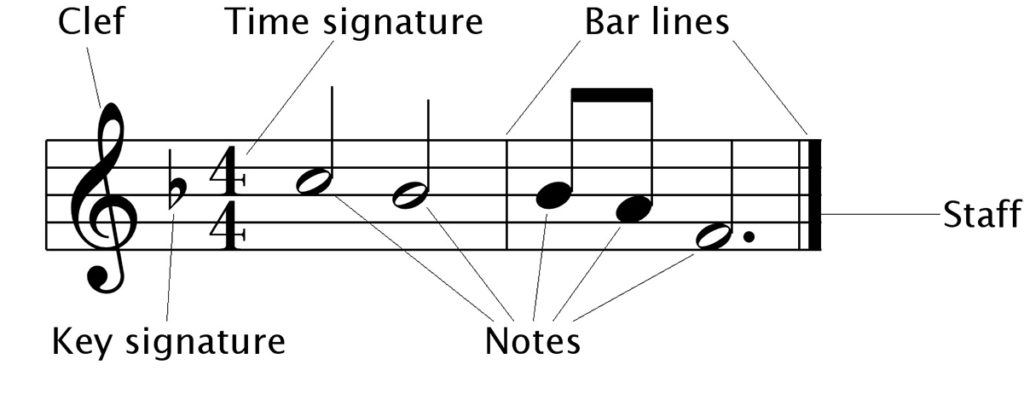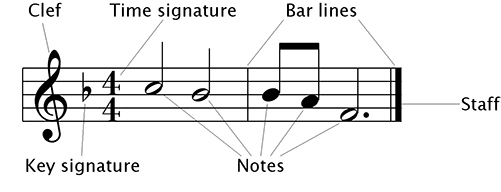Music is a universal language, and people of all ages enjoy it. But, how does one understand the meaning and rhythm behind the music? Music theory helps to break down what we hear.
Musically speaking, a bar or measure of music is a segment of time featuring a specific number of beats determined by the time signature. Vertical bar lines indicate the boundaries of the measure.
Measures exist to organize long pieces of music into smaller units. It’s like sentences make up a paragraph. And later on, you’ll learn about double bar lines, which are used to represent larger sections of music. Like how articles, such as this one, are divided into paragraphs.

Are a measure and a bar the same?
This question has somewhat of a debate behind it, depending on how technical someone wants to get about it.
In general, a bar and measure can be used interchangeably when talking about a section of music.
However, technically speaking, bars are the vertical lines that define a set of notes, and the collection of notes between the bars is a measure.
How to Read a Measure of Music
A musician reads a measure of music from left to right, playing the notes in order as they appear. The basics of tempo, meter, and note values must be understood in order to interpret a measure of music. This information is usually given at the beginning of a line of music.
The following are the most important things to know when reading a measure of music:
Time signature: The time signature determines the number of beats in each bar as well as the note value of the beat.
The top number in a time signature represents the number of beats, and the bottom number represents the duration of each beat.
3/4 time, for example, indicates that there are three beats in each measure and that each beat is one-quarter note long. 3/4 time is very common, but the most frequent time signature in Western music is 4/4, or common time.
- 4/4 denotes that each bar has four beats, with each beat having a quarter note duration.
- 3/4 denotes that each bar has three beats, with each beat having a quarter note duration.
- 6/8 denotes that each bar has six beats, with each beat having the duration of an eighth note.
Note values: A measure contains one or more notes. Each note lasts for a specific quantity of time, as specified by the time signature. Quarter notes, for example, last for one-quarter of a 4/4 measure.
Tempo: The tempo of a section of music is the speed at which it is played. The song’s tempo can be identified using beats per minute (BPM) or by employing descriptive phrases (typically Italian words describe tempo, such as adagio or andante).
If you’re ever looking at a sheet of music and see Italian words, this is why.
Bar Lines Explained: 6 Types of Bar Lines and Their Meanings
Different types of bar lines appear in sheet music, each type indicating the start or end of a measure and communicating instructions for the player.

1. Single bar line: A vertical line that marks the end of one measure and the beginning of another. It can be compared to a sentence in a paragraph.
2. Double bar line: The end of one section and the beginning of another are signaled by two side-by-side vertical lines. It can be compared to a paragraph in a story.
3. End bar lines: Two vertical lines with the second line thicker than the first. This indicates the conclusion of a musical period or composition. It can be compared to finishing reading a story
4. Begin repeat: The first line is a little thicker than the second, and it’s followed by a pair of dots that resemble a colon punctuation mark. This indicates the first measure of a repeated section.
5. End repeat: The begin repeat, flipped backwards. This indicates the end of a repeated section, and everything between the begin repeat and end repeat gets repeated once.
6. Begin and End repeat: Combining the begin and end repeat symbols. This symbol indicated the end repeat of one section of music and the begin repeat of another section of music.
Conclusion
It is important to understand the basic concepts of time signature and note values to read and play music correctly.
Each measure in a piece of music contains either one or more notes, which are specified by the time signature.
The tempo of a song can be identified using beats per minute (BPM) or by employing descriptive phrases (typically Italian words describe tempo, such as adagio or andante).
Different types of bar lines appear in sheet music, each type indicating the start or end of a measure and communicating instructions for the player. Understanding these symbols will help you follow along with any piece of sheet music.


Hi there! I just stumbled upon your website while researching about bars in music, and I must say, your article is incredibly informative and well-written. It provides a clear explanation of what bars are, the significance of measures and double bars, and even offers guidance on how to count bars of music. As someone who is passionate about music, I truly appreciate the valuable insights you have shared. Your website is a fantastic resource for both beginners and seasoned musicians alike. Thanks for this great piece, it definitely increased my understanding of music composition. Keep up the fantastic work!
Best regards,
Bella Montgomery
Thank you! I’m glad I was able to help.